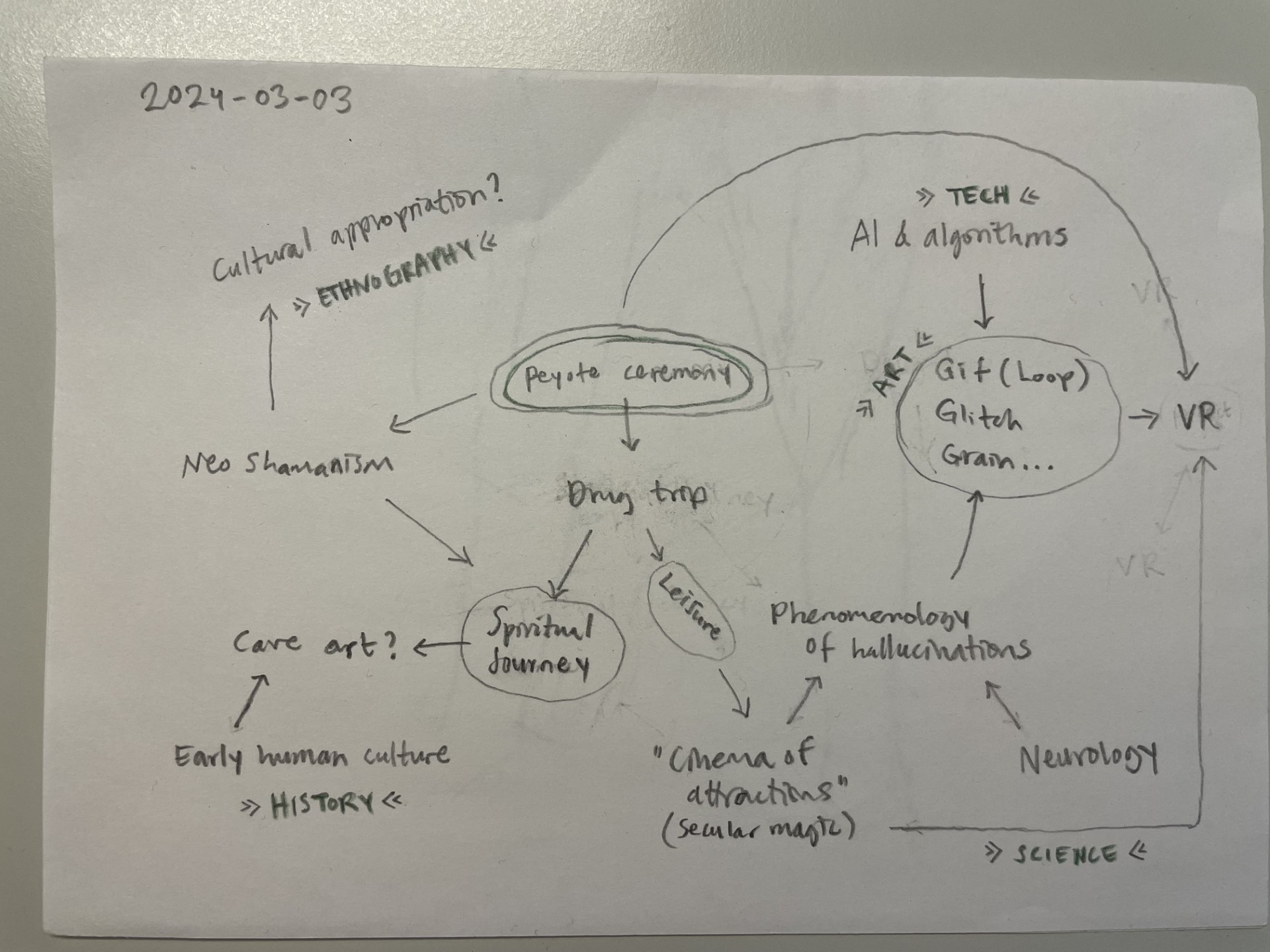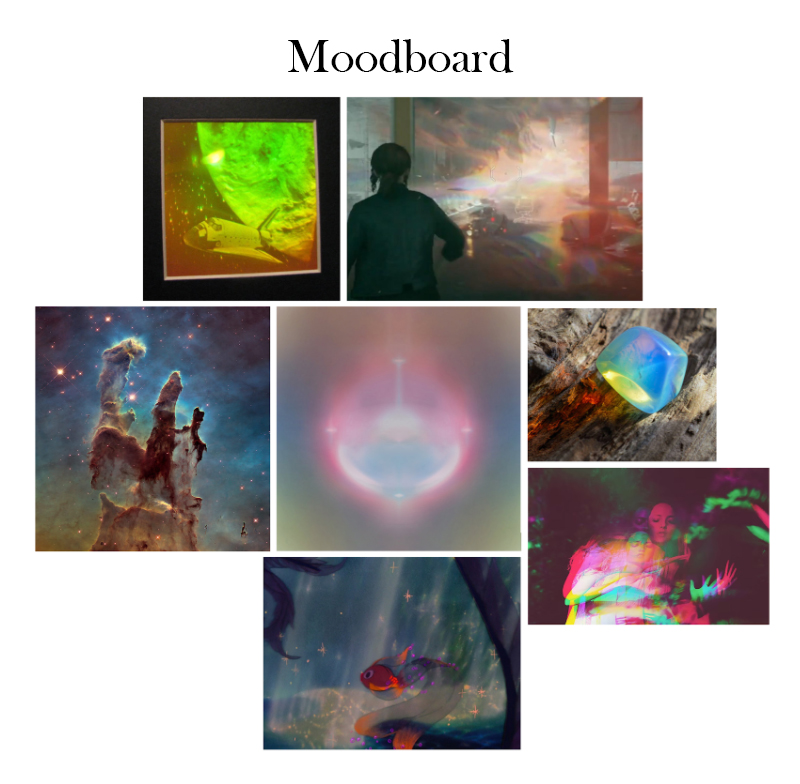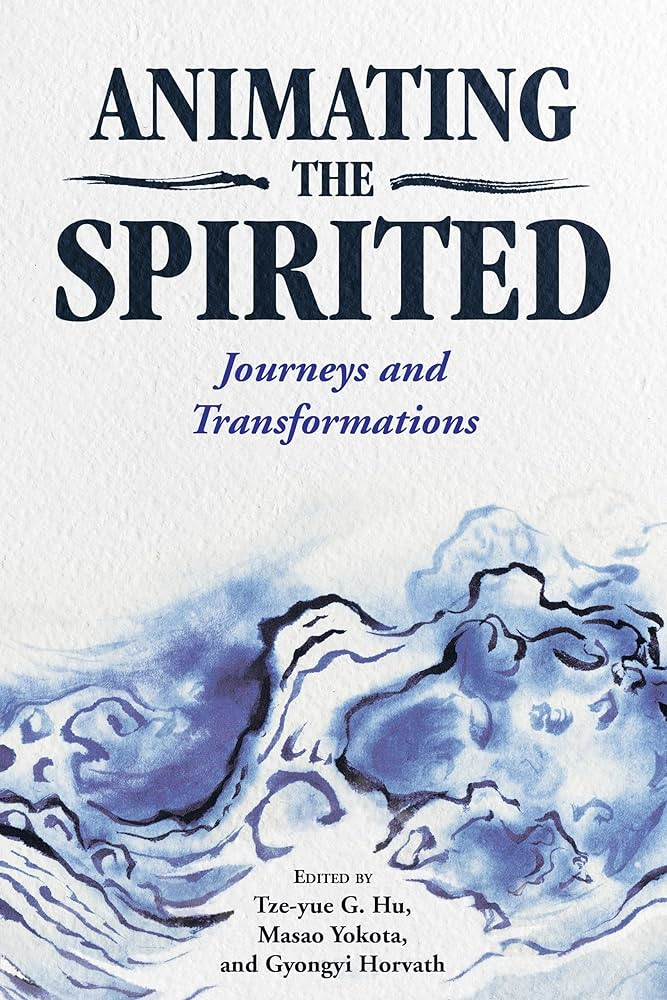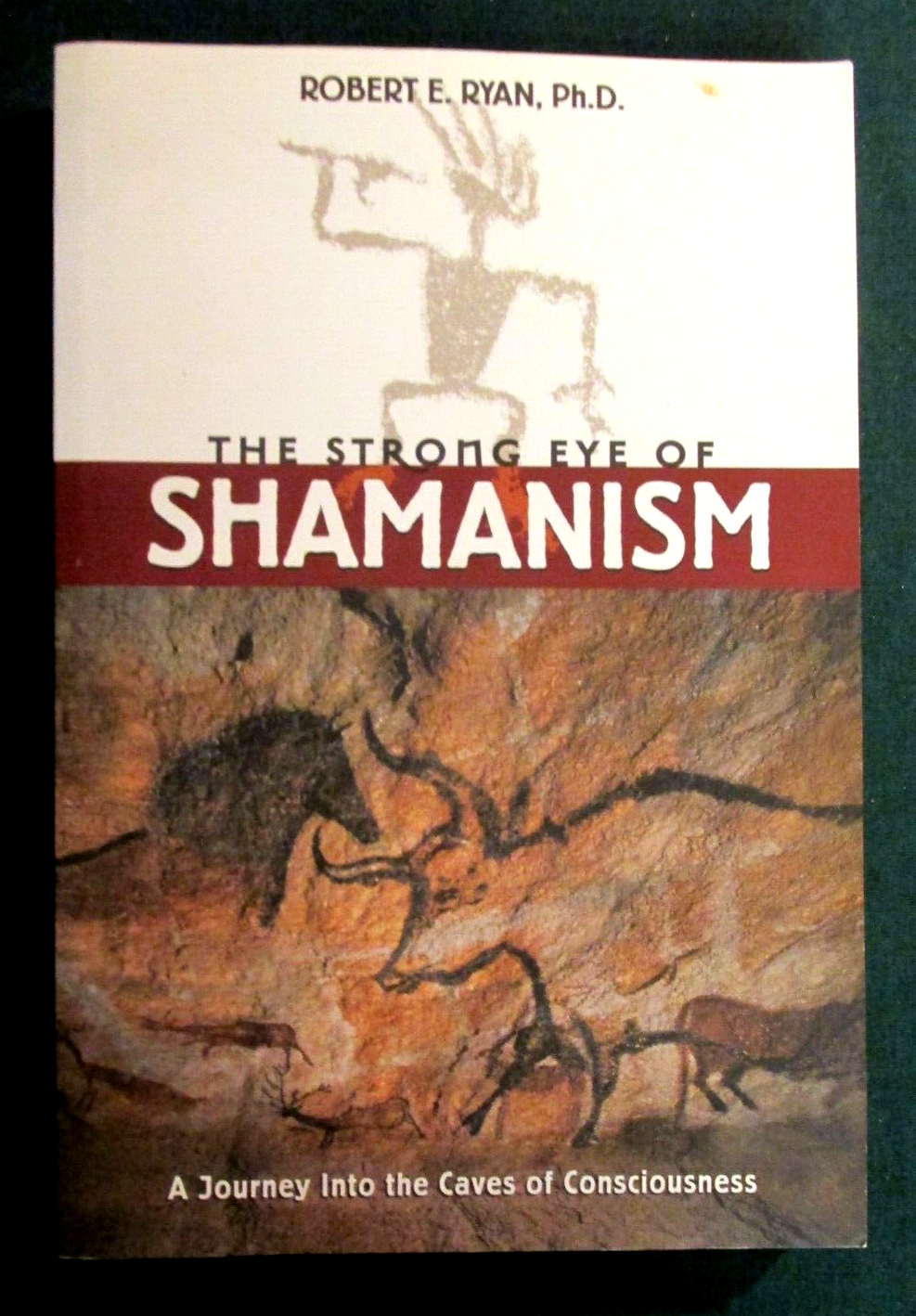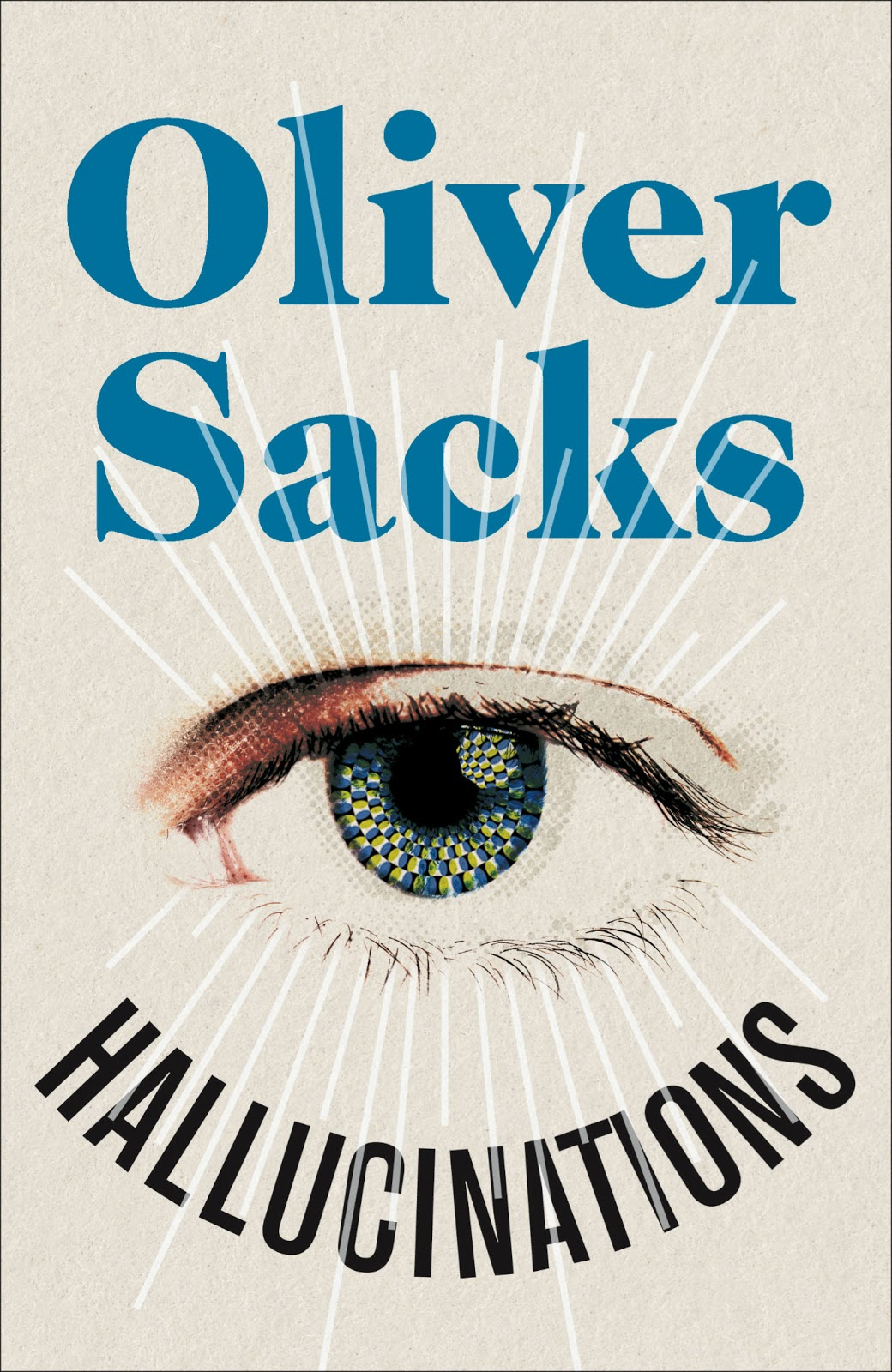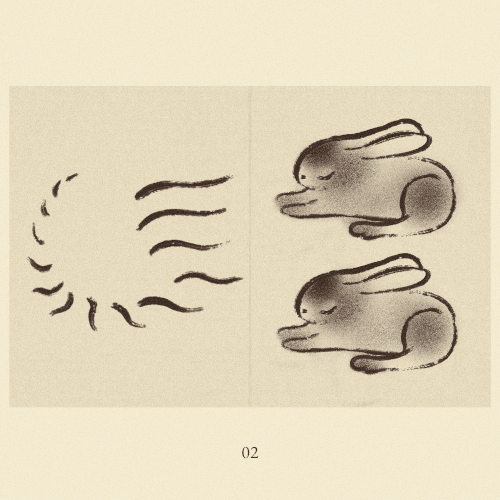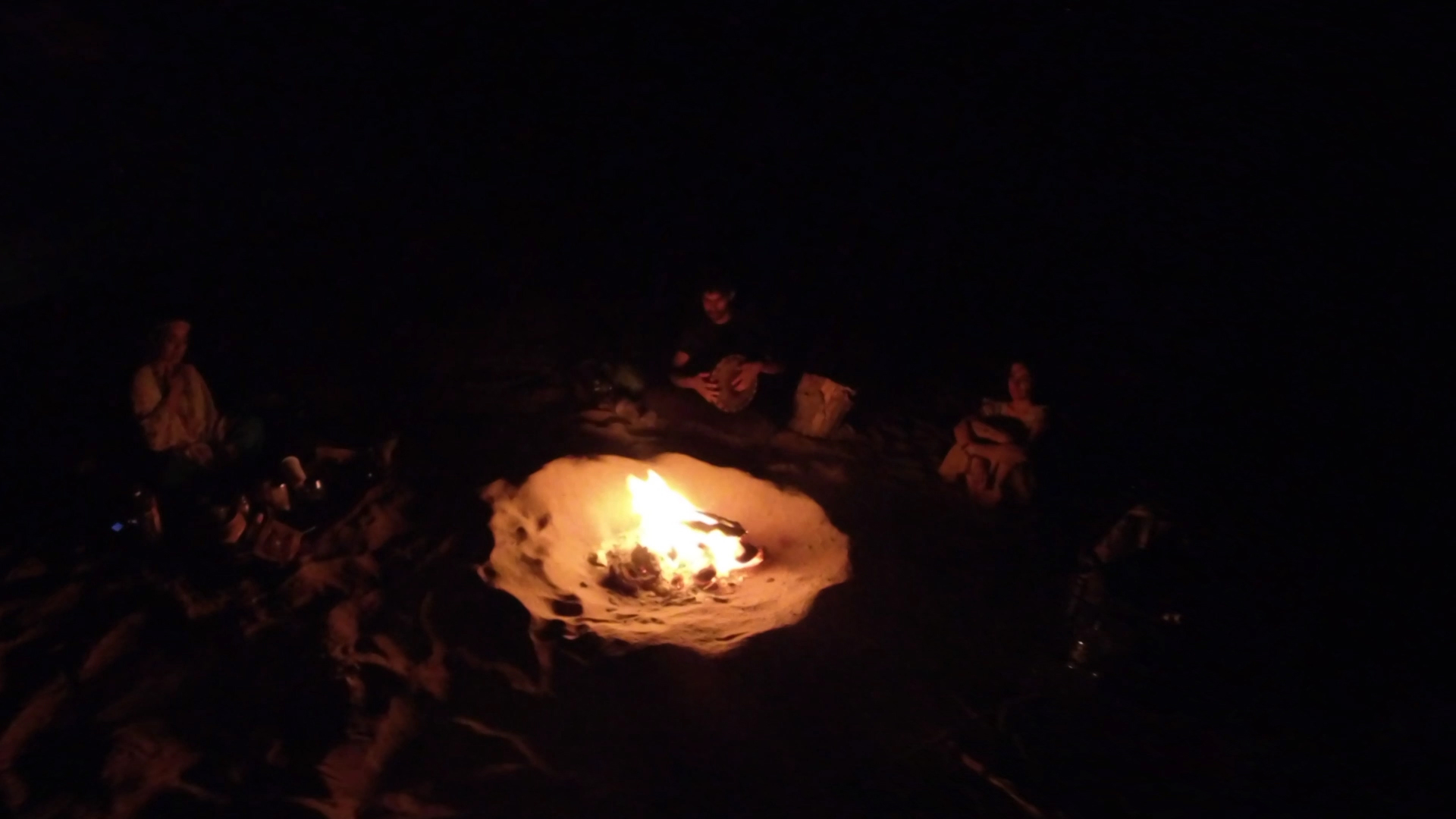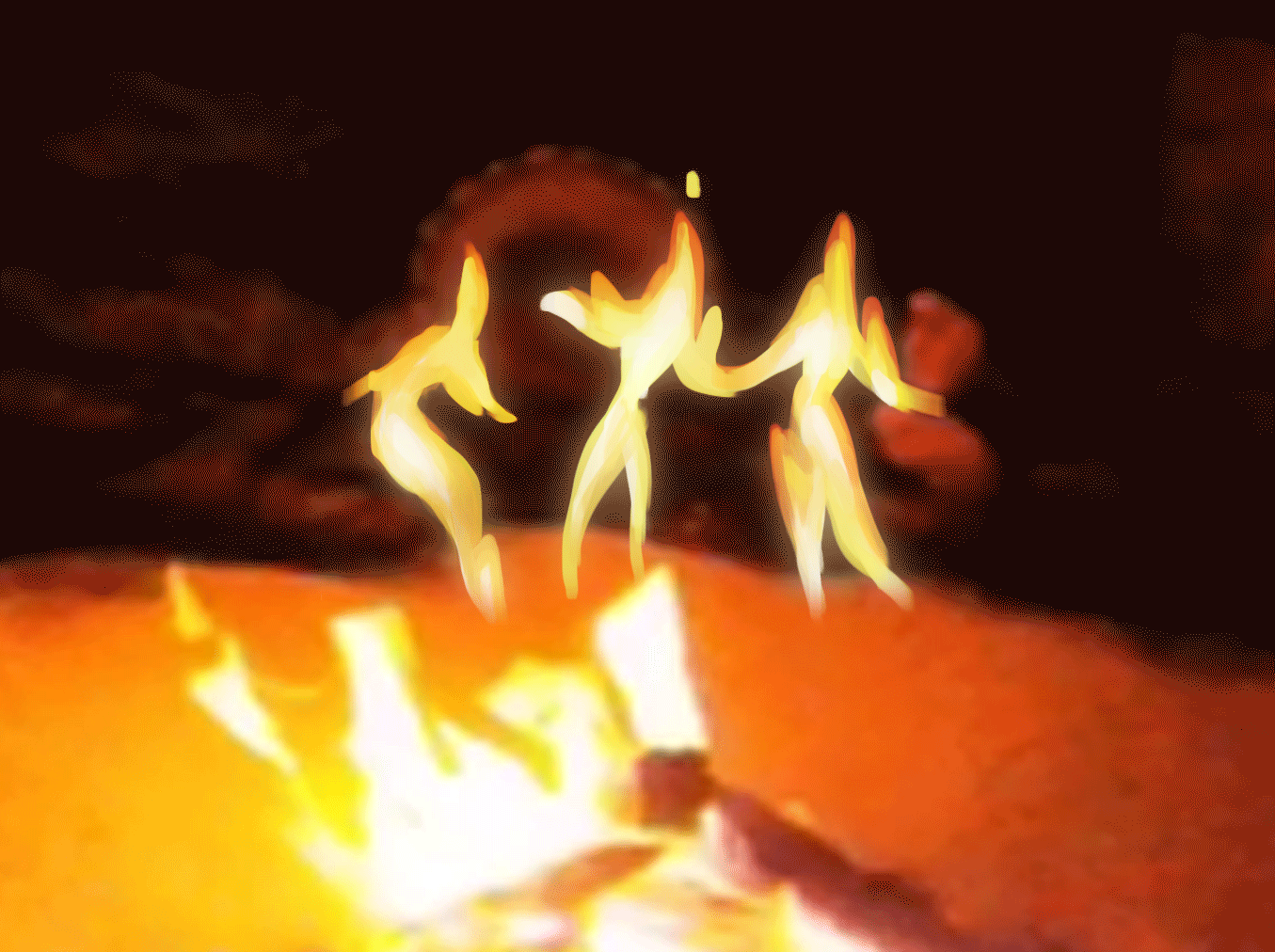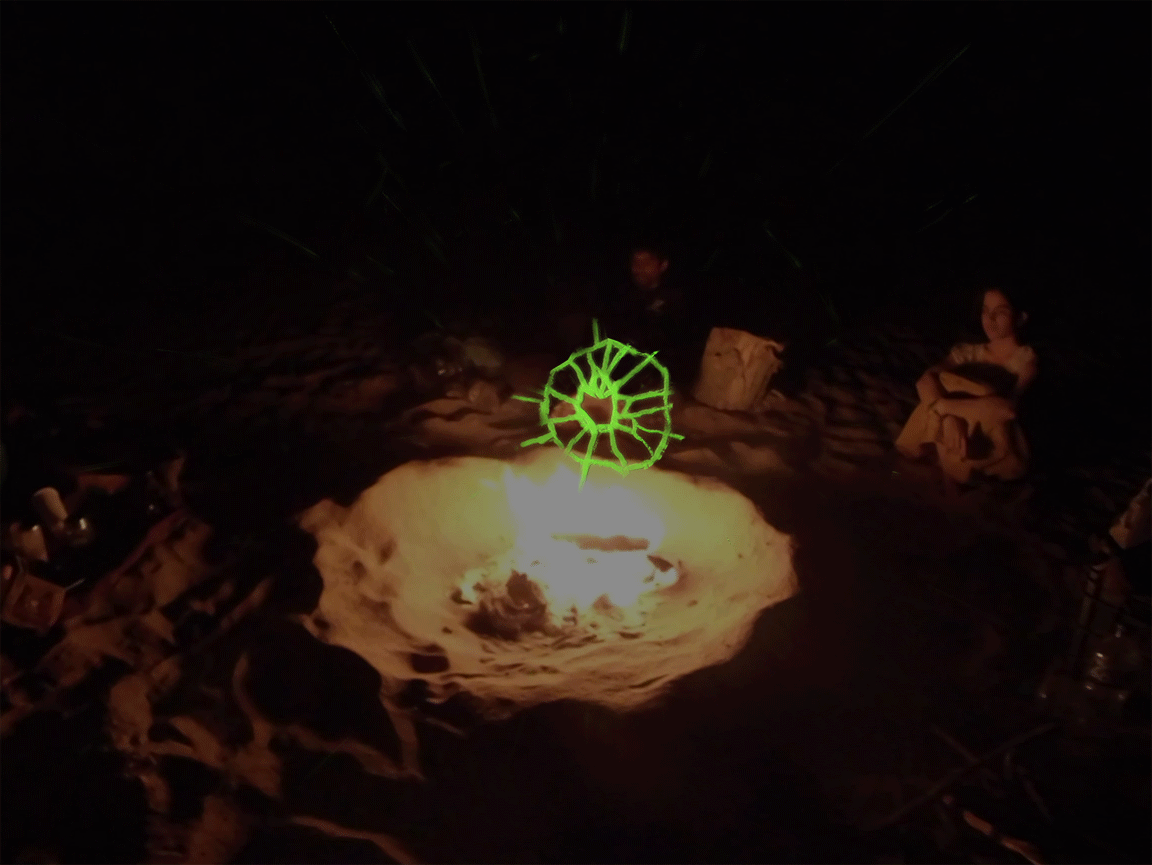Welcome to my project page for a Master's degree in Animation at Stockholm University of the Arts, 2022-24.
I was asked to animate the hallucinations for a VR (Virtual Reality) experience of a Peyote ceremony. The peyote is a hallucinogenic plant that is consumed to heal the soul in a collective ritual among several native Mexican tribes, such as the Huichol1.
Since I haven't taken drugs myself, I’ve had to rely on interviews and other documentation to uncover the phenomenology of hallucinations, especially those of peyote consumption. The authorship of “drug trips” in films come into question, as does my cultural appropriation of ancient healing rituals.
The craft of animation has long been used to visualize psychedelic experiences2 and whether or not their appearances are “authentic”, the fact remains that the subjectivity of the author and the possibilities of technology limit the outcome. Therefore the primary focus will be on the inner journey - of the drug user, but also the animator.
/Emma
2024-01-24 (Edited 2024-04-17)
1. Ryan R. E., (1999) The Strong Eye of Shamanism, p.95-103
2. Broughton M. (2015-07-11), Who took the drugs? Displaced Hallucinations in Psychedelic Films, University of Hertfordshire
A first moodboard for the style of the "hallucinations". (It was used for describing ideas, but not so much for the actual production).
Images (top to bottom, left to right):
The translucent effect of a matted hologram picture
Screenshot from the game Control (Remedy Entertainment, 2019) featuring a shimmering rainbow effect
Hubble telescope images of nebulae (M16, Eagle Nebula, NGC 6611)
The cover to album Therapy (2023) by Brendan Eder Ensemble
The color of an opalite stone (image from gandharagems.com)
Image by Rus Khasanov showing "photographic chromatic aberration" (also found as an effect in Photoshop)
The “gossamer effect” from the underwater scenes in Disney’s Fantasia (1940) (See: The Illusion of Life, p.272-274)
Above are some of the books I've read and used as a reference for my writing and for my animations (left to right): Animating the Spirited (Hu T., Yokota M., Horvath G. 2020. University Press of Mississippi), The Strong eye of Shamanism (Ryan R. 1999. Inner Traditions), Hallucinations (Sacks O. 2012. London Picador).
2024-02-27
Since the last entry I've had the chance to learn more about the hallucinations and the peyote ceremonies that Nicia experienced in Mexico last summer (to the left are some reference images she gave me).
The four hallucinations that I chose to go with are:
1. Firelike figures appearing among the flames of the fireplace, dancing.
2. Purple smoke rising from the fireplace and coming towards the viewer.
3. A deer made of wood, standing restfully in one place.
4. A hole punched through the “fabric of reality” (it resembled how a glass would shatter but in the form of a glowing, neon green spider’s web).
See more under "Animating the Hallucinations".
Image references (top to bottom, left to right): “Gold reindeer isolated on a transparent background” by Chantelle Flores on vecteezy.com, “Mesmerizing Flame” by Jesse Phillips on deviantart.com, Purple smoke from freepik.com,“Purple web” by LadieViolet on deviantart.com (but provided in green on pinterest.com).
Artistic References: The Gif
I’ve chosen to make a series of looping animations to represent the hallucinations in Nicia’s recorded ceremony.
The loop is a great way to save time. If it’s made seamless, with no visible end or start, the mind may be tricked to think that the animation is longer than it really is - that it has a life of its own. But perhaps more importantly, the loop can have a mesmerizing effect, if made clear enough and not too long: subtly accentuating a rhythm.
The GIF quickly became my go-to format when I learnt how to animate in Photoshop, around 2013. The GIF was easy to export - leaving me free to animate with just the heavy file compression and lack of sound as potential drawbacks.
The GIF is a digital file format developed by Compuserve that has been around since 1987 and has been popular due to its high compatibility on the Internet. In an article from Smithsonian Magazine (2017-06-02) Lorraine Boissoneault writes about A Brief History on the GIF:
"Part of the reason the GIF survived even after the GIF purge, Eppink thinks, is because it fit the DIY spirit of the early Internet. It was a small file, it could be downloaded and stored on individual servers, and nothing really came along to replace its animation style: that short, continuous, soundless loop." (Accessed: april 2023)
Artistic References: An Interview with Iris Wildros
Iris Wildros is a multidisciplinary artist living in Stockholm, whom I found on Instagram through one of her looping animations. The papery, Indian ink-style moved on the screen in a slow and fragile way that really spoke to me. It was dreamy and gently hypnotic. She is touching upon the same sort of qualities and expressions as I am, especially now for this research on hallucinations. Seeing the similarities in our styles, I asked Iris for an interview about her creative process. She kindly provided answers, which have given me food for thought in both my research and my animation work in general.
Q: How did you find your way into animation and creating animated loops?
A: I found my way into animation by taking courses on visual communication and digital experience design, which briefly covered various forms of animation. It was when I tried frame-by-frame animation that I experienced how meditative the process could be (particularly under certain circumstances). This led me to pursue the animation path I'm currently on. The creation of loops began with me seeking ways to consistently finish pieces and build a vault of "practice pieces" to facilitate feedback, learning, and iteration when I was first starting my practice.
Q: What role does technology have in your animation process?
A: At this point, my process is fully digital, but I try to set boundaries on what I allow myself to use - This includes such as for what cases I use technological solutions and programs, as well as, for example, limiting the ability to undo too easily, and using only frame-by-frame processes. Almost all of my animations are made on my iPad in Procreate, as I find this to be the most accessible way to achieve the expressions I'm seeking to create.
Q: What are your thoughts on meditation through animation as the animator/viewer?
A: I find that the creation of frame-by-frame animation can be very meditative, especially when space is left for slightly intuitive choices. The focus required to create an animation makes the process quite immersive. When I perceive an animation that loops on very few seconds (around 3-9 s) for long enough, a rhythm experience is created by the visuals themselves. However, I find that the rhythm experience can be altered when I change the soundtrack that accompanies it.
Regarding meditation through animation for the viewer, I believe that especially looping animations have the ability to create a meditative state. I also believe that the immersion of looping animations can be used to center oneself in a meditative way. I also find that slightly abstracted visuals have the potential to facilitate contemplation or wonder which can also be meditative.
Below are three gifs by Iris Wildros, acessed through her site.
Iris' answers made me believe I was tapping into a current need – of my own and in society in general: The need for mindfulness. Various types of art therapy-like videos have been trending in my Instagram feed: people drawing slowly on a meticulous drawing, or someone blending luscious blobs of paints. The videos provide a tactile and meditative experience, as they compete for attention in a tumultuous cyberspace.
The American Art Therapy Association3, founded in 1969, explains that “art therapy engages the mind, body, and spirit in ways that are distinct from verbal articulation alone. Kinesthetic, sensory, perceptual, and symbolic opportunities invite alternative modes of receptive and expressive communication, which can circumvent the limitations of language. Visual and symbolic expression gives voice to experience, and empowers individual, communal, and societal transformation.”
There is a lot to be said for the potentially transcendental process of making art.
The book Animating the Spirited (Tze-yue G. Hu, Masao Yokota, Gyongyi Horvath, 2020) features several essays on the subject of a spiritual animation: from sufi calligraphy to Daoist narratives. An essay by Koji Yamamura stands out to me: ‘Transforming the Intangible into the Real: Reflections on My Selected Animation Works’. He writes on how the subconscious can be used to achieve a “transcendence of the dualism of mind and matter”. The subconscious method seems relevant to me because I’m working with subjects of mind. I think technology could help me achieve such a method, if I only find the right entry point.
3. The American Art Therapy Association, ArtTherapy.org, accessed: March 2024
Artistic References: The Glitch
Moving on from the loop I’m also interested in another digital phenomena: the glitch. A glitch is a term for ”a small problem or fault that stops something working successfully” (Oxford Advanced Learner's Dictionary), in this case a software or a hardware system. It might look like a sudden jumble of pixels or just a strange line. To me, the glitch borders onto the fabric of hallucinations, such as mentioned in this quote from a delightfully animated TED-Ed video on Hallucinations (Cox E., 2023-05-23):
“When the visual cortex processes light into coherent images, it fills in these blind spots with information from the surrounding area. Occasionally we might notice a glitch, but most of the time, we’re none the wiser.”
For my bachelor’s thesis at Blekinge Institute of Technology in 2014, I wrote with my partner Marcus Lindgren about a method for how to work “with” the computer as digital artists (Lindgren M., Richey E. Digital Materia). Here, the glitch was seen as the ultimate digital expression, while the collection of data was used to inspire our own digital art. The image below illustrates the process suggested in the thesis Digital Materia (2014): collecting data, interpreting it etc.
To the left is an image from the thesis Digital Materia that uncovers the hidden algorithms of Photoshop's sharpen tool. By letting the sharpen tool repeatedly process an image: maze-like patterns are created.
These patterns reminds me of an alien language or the kind of patterns that might appear under one's closed eyelids - "phosphenes". Karolinska Institutet decribes this phenomena:
"A subjective visual sensation with the eyes closed and in the absence of light. Phosphenes can be spontaneous, or induced by chemical, electrical, or mechanical (pressure) stimuli which cause the visual field to light up without optical inputs." (mesh.kib.ki.se, accessed 2024-04-17)
Artistic References: Code, AI and Algorithms
I was interested to see what virtual hallucinations might have already been made with the use of VR technology and came across an article by Suzuki, K., Roseboom, W., Schwartzman, D.J. et al. from 2017: A Deep-Dream Virtual Reality Platform for Studying Altered Perceptual Phenomenology. In the article’s introduction the researchers briefly present the product of their project The Hallucination Machine:
“It comprises a novel combination of two powerful technologies: deep convolutional neural networks (DCNNs) and panoramic videos of natural scenes, viewed immersively through a head-mounted display (panoramic VR). By doing this, we are able to simulate visual hallucinatory experiences in a biologically plausible and ecologically valid way”.
They go on to suggest that their system induces a visual phenomenology “qualitatively similar to classic psychedelics”. Despite this research being almost 10 years old (at the time of writing), they could use machine learning to create deep neural networks (DNNs) comparable to those of a human brain.
In order to enhance the immersiveness of the experience they also chose to work with VR. Like Nicia, they use a pre-recorded 360-video from a head mounted display, but instead of adding artificial 2D animations to the video in post production, they used the Deep Dream algorithm to produce hallucinations. In the end they compared the simulated experiences produced by the “Hallucination Machine” to those of pharmacological psychedelic states, by having participants rate their subjective experience using an ASC questionnaire developed to assess psychedelic experiences.
This cold, pragmatic report makes me realize that a spiritual take on the subject of hallucinations might be a needed alternative in my field.
Hallucination no. 1: Firelike Figures Dancing
The first step for me was to export a still frame of the fireplace that I could use as a reference background in Photoshop. With the image in place, I sketched out three stick figures that danced together. I did not ask Nicia how many she’d seen, but I thought three dancers was the minimum number for the dance to appear more “ritualistic” than romantic.
Once I had the stick figures dancing in an animated loop, I drew flames on a new layer that flared with the movement of their bodies, one frame at a time. I used the reference images that Nicia gave me as a guide for the colors and shapes. I had to keep myself from adding effects like chromatic aberration or similar - the flames needed to look as real as possible.
I aimed to have a rising, fabric-like motion in the flames – and let them disappear into sparks now and again. With just enough variations in the flames I aimed to make the loop feel alive and not too noticeably repeating. I also had to tone down the motions of the figures – the waving of the arms and legs – so that they wouldn’t take the focus from the flames. Meanwhile Iris Wildros’ thoughts on abstraction echoed in my head “(...) slightly abstracted visuals have the potential to facilitate contemplation or wonder”. Perhaps I shouldn’t be too concerned with a real look?
Lastly, I added a glow effect to make the flames feel a bit more voluminous.
Nicia’s neoshaman sister had called these firefigures “fairies”, which I thought was sweet because it evokes a sense of naive, childhood magic. Symbolically fire is often seen as a source of creativity and creation, which I chose to see as a manifestation of Nicia reaffirming her family bonds.
Notably, this animation was the only one that ended up being a complete loop.
Hallucination no. 2: Purple Smoke
According to the neurologist Oliver Sacks, the existence of the color indigo is disputed, and to him it had first been visible through the use of hallucinogenic drugs (Hallucinations, p.110). To me indigo is the dark, bluish purple of a late evening sky in the summer, but I could be wrong. Physically the color purple – or violet – has the shortest wavelength, while ultraviolet is invisible to the human eye (science.nasa.gov, “Ultraviolet Waves”).
Nicia told me she’d seen purple smoke rising from the fireplace and coming towards her under the influence of peyote. Coincidence or not, one of my art teachers at Blekinge Institute of Technology said that purple was often used to visualize magic, because the hue so seldom appeared in nature.
Anyway, at first I was reluctant to animate smoke. Smoke is tricky because of its transparency and constant motion. Every brush stroke and textural shift is visible to the beholder, while it’s continuously rising and morphing at the same time. I’ve been asked to animate smoke in 2D for video games before (Barmark, 2015 and Tiny Echo, 2017) and I’ve always struggled capturing the floating feeling without jerkiness. I’ve found myself rushing – which says a lot about my process in animation: I like to work broadly and not meddle with perfection. All effects that are natural (smoke, water, fire) inevitably demand more attention, because the eye knows what real smoke looks like (especially when there’s a photorealistic background!).
What I need now is to study how smoke moves in detail, by watching various video references, frame by frame.
Hallucination no. 3: The Deer
Nicia tells me that if a person sees a deer while under the influence of peyote, the deer is interpreted as the “Grandfather” coming to guide them. In other words, the deer is the incarnated form of the peyote spirit.
Nicia saw a deer made out of light birch wood, standing beside her. The “peyote deer” is said to be blue so she asked me if I could color it too, but I said that I wanted to keep it as close to her memories as possible.
I started with the shape of the deer, which came naturally to me. I have drawn many animals for video games (Barmark, Meadow etc.) and could leave it to muscle memory (besides, if it was made out of wood it could look a little choppy). However, the texture was harder to draw so I decided to work with photos to capture the feeling of the grain. By using the layer property “overlay” or “multiply” I could transpose some of that grain onto my drawing, blending them.
Nicia told me that the deer could be standing in one place, so it would basically have what is known as an “idle animation” in video games. An idle animation is the default, resting state of a character: They breathe and their clothes or hair might move in the wind. Through code, animated variations can be randomized: the character looks around or yawns etc. I’ve always loved these “hidden” animations because they give a sense of character and only appear when you, as a player, have stood still for a while. The variations are mostly cosmetic, which make them all the more fun.
I won’t be using code to randomize variations because I don’t have the time to get into coding. Instead I will try to balance the variations with their occurrence, to make the motions feel natural while still “interesting”.
Hallucination no.4: A Web between Worlds
Lastly I animated a “crack in reality”, that was to look like a green glowing spider web. I chose to look at the crackelation of broken glass as a visual reference.
I started with drawing the whole web and then animated it backwards. In other words: I copied the frame of the fully drawn web and erased parts of it, step by step, and lastly reordered the frames so that the crack was growing instead of shrinking.
This hallucination was the most abstract one, which made it both easier and harder to make. I was freer to explore and interpret it, but when it was finished it was tricky to blend into the rest of the video. The strong green color seemed to distract the eye from any animation that might be happening. Only the whole shape of the web stood in focus like a strange blotch in the dark. So I gave it a flickering effect in Premier to make it feel less tangible, while highlighting some of the "shards" to make it feel more glass-like.
The crack in reality is to me the most spiritually suggestive hallucination out of the four that I animated. It’s as if Nicia got a glimpse at “the cosmic threshold”, peeking into the world of spirits beyond our physical realm, or the “Matrix” as Nicia called it. The glass texture itself suggests the breaking of a lens or digital screen, while the similarity to a spider’s web draws my mind to Joseph Campbell’s studies on myths and the spider’s symbolism: as a world creator and a weaver of fate.
2024-04-18
Thoughts after the animations are made
In the final chapter of this paper I will try to summarize the outcome and analyze the result. The VR film Urban Witches is meant to show Nicia’s journey – from wanting to reconnect with her family and in doing so: reconnect with nature and herself as well. At the same time the film wants to invite the viewer on their own spiritual journey, which was perhaps a fool’s errand. The mix of intentions is confusing to me as a viewer.
As for the hallucinations, I feel like they ended up a bit “gimmicky” after all. The low frame rate makes the animations look choppy and unnatural. To me the most believable one was the deer: because it didn’t move as much and because it blended into my periphery with its darker colors. It felt less forced and left more to my imagination. Maybe 2D animated hallucinations just need to be subtle to work?
Inorder to see how well we succeeded, other people will be asked to test Urban Witches and answer some questions. But first let me tell you what I experienced.
2024-05-03
As I put the VR headset over my head, the room around me goes black. The screen in front of my eyes lights up to reveal a bonfire in the desert. It is night and the firelight flickers over the two other people sitting beside me. At first only the sounds of the crackling fire and the occasional noise of wind is heard. A lightning bolt strikes, purple in the horizon. My view is that of Nicia’s: If I look down I can see her legs and arms.
The shaman - Nicia’s sister - starts to chant and blow through a horn. One blow in each direction: North, East, South and West, to ask the spirits and other shamans for permission. It sounds like an unstable trumpet, which makes me smile. The shaman then talks about the meaning of peyote - as a healing plant for her and others, while cleaning the air with palo santo (incense). She prepares the peyote beverage and gives me a cup. I drink it and there is a cut to a new scene.
The camera becomes wobbly: I feel like I’m flying a little above ground. Something strange is happening to me. There is a new cut and I’m seated more securely in front of the fire again. The shaman and another person are calmly singing and drumming, but the music I hear is from another source. It pulls me away from my current reality.
The dancing figures appear in the fire. They loop there for a while, drawing my attention towards them. They are choppy and a bit opaque – quite different from the fire behind them, so their small size helps them to “blend in”. Then comes the trail of smoke, rising out of the fire – first only to disappear and then it appears again – headed towards me. Its bright purple color shines out of the darkness.
The calm deer appears like a steady comfort beside me, while thunder starts to brighten the sky in sudden flashes. The lightning continues to strike… a third time, a fourth time. It’s truly a haunting scene.
Then the glass-like web appears like a strange splotch of green lines in my periphery. Once, twice… I can barely make it out before it’s gone.
There is a cut again to a new view of the desert, overlooking the mountains and the rising sun in timelapse. I feel relaxed as the slow sunlight appears and the clouds rush by, far above my head.
The video ends with me (the camera) being carried out of the desert in the morning sun. The credits are rolling as I look out over the vast sand dunes, rocking with the gait of my carrier.
Still from "Urban Witches", filmed by Nicia Fernandez
2024-04-29
The next step in my research was to ask a couple of questions to a group of people on how they experienced the film after watching it with a VR headset. I wanted the questions to be easy to answer while still providing enough information for me to see how well I (or we) had succeeded.
Result & Summary
23-05-2024
Eight testers took the time to answer four questions after experiencing Urban Witches. Three of the questions were based on a value from 1-10 for easy evaluation.
1. How do you feel now? (1 Confused - 10 Content)
2. How did you experience the hallucinations? (1 Tiresome - 10 Intriguing)
3. Which hallucination spoke to you the most? (Optional: Why?)
4. How transcendental did your experience feel? (1 Not at all - 10 Very much)
The average value for each answer has been calculated from the 8 anonymous testers (unknown age and gender) and are shown by the corresponding number below.
1. An average of 61,2% felt content. (6+10+9+10+7+8+5+3 = 49/80).
2. An average of 72,5% felt intrigued. (6+10+9+8+8+7+10+8= 58/80).
3. The purple smoke (B) and the fire people (A) share 1rst place (three each). (A, C, A, B, A, C, B, B).
4. An average of 67,5% felt the experience was transcendental. (7+9+7+3+10+ 4+4+10 = 54/80).
Total value 161/240 = Our experience was 67% “successful”.
Question number 3 was not based on a rating from 1-10, but instead asked the tester to pick 1 of 4 hallucinations and then describe briefly why it had made an impression on them. Three testers left no comment. Three other answers revolved on the experience in general while two stated that they didn’t notice all the hallucinations. One of them also commented that the last part was very peaceful (watching the sunrise) and another said they enjoyed sitting around other people in the desert. The flying sensation after drinking the peyote was appreciated, while another one of them wished for more hallucinations.
Taste, personal background and context are affecting factors, which are probably the cause for the varied answers. My conclusion is that most people needed more information to fully appreciate what they were watching (subtitles for the spoken Spanish) and that my hallucinations weren’t as obtrusive as I’d believed them to be.
A Meditative Animation Method?
While studying shamanism and working on the animations for Urban Witches, I felt an urge to analyze my process. I was drifting more and more away from technology, into my own heart and mind – finally beginning to accept the open fields of artistic research.
A certain course at SKH came to my mind called “Presence in Artistic Practices - Yoga and Sustainability” which I was able to join last fall, 2023. It gave me new perspectives on my creative process as an animator. Through mental and physical practice I became more aware of my limits and gained better control of my body. I did not really realize it then, but being more aware of my body made me understand movements better when animating. The mind was harder to control, but using the breath to establish a sense of calm was helpful. As the yoga master Iyengar says (p.55):
“When the action of the breath on the mind is studied and understood, it becomes spiritual. prāṇāyāma is the bridge between the physical and the spiritual.”
Many of these lessons seem obvious now when I look back, but sadly I easily fall back into old habits. Being more forgiving of myself has proved to be the most important step for my mental growth lately. I feel like this has enabled me to be more generous with myself and others as well. Besides forgiveness, there are other aspects that would enhance my focus and creativity in the animation process. After reflecting on the “yoga course” and the interview with Iris Wildros, I formed a list of prompts for an intuitive process:
Remove distractions: noise, clutter and even internet access if needed.
Slow down – take a moment to think before starting a new step.
Be open to faults and the unforeseen (as a part of forgiveness).
Let go of prestige and false demands.
Focus on the craft: It’s OK to repeat a subject. Repetition is practice.
Let intuition be a guide in the animation process.
Feel the direction of a motion (use your breath to gain a better understanding).
Try to hear the motion, to convey an impact or a rhythm.
What I hope to achieve is a heightened sense of focus and awareness in my process, and ideally find a key to meditation through animation. Since I was “hired” by Nicia to animate, an interpretive process was the natural option, but as an artist I believe I have more to explore in my own, inner journey if I let intuition guide me.
Below are two such tests, animated straight-ahead in Photoshop.
Process diary (in Swedish)
2024-04-20
Jag vill animera papper. Jag försöker rita grässtrån gjorda av papper, som en klippt frans, men formerna känns tråkiga.
Jag ritar ett hopknycklat pappersbit istället.
Jag börjar animera att den öppnas, vecklas ut, men vet inte hur formen ser ut längre. Pappret delar sig i tre mindre ark. Egentligen borde jag studera hur ett pappersark ser ut när de vecklas upp, men det är roligt att upptäcka de former som dyker upp. Jag leker medan jag fyller i, skuggar, suddar, roterar – min intuition leder mig.
Endast rörelsen och den omöjliga formen är min uppgift.
Så underbart det är att animera på något eget igen!
2024-04-21
Det hopknycklade pappret påminner mig om en slängd skiss, en dålig idé.
Jag kopierar föregående bildruta, vrider och vänder de delar som ska förflytta sig och fyller i de tomrum som uppstår.
Ibland måste jag rita om formerna helt, framförallt då pappret viks eller roteras i djupet.
Jag kopierar första bildrutan och redigerar den så att den blir en övergång till sista bildrutan. Jag har nu en enkel loop – en någorlunda sömlöst repeterande animation.
2024-04-22
Nu har jag 26 rutor. Loopen är mjukare men fortfarande ganska snabb. Ljudet rörelsen framkallar i mitt huvud är: “Huaaaaah–ik–SCH!”.
Om jag vill ha en mer meditativ effekt på animationen borde jag göra den långsammare. Det kräver mer arbete. Kanske gör jag det senare.
Nu vill jag testa att göra en ny “öppnande" animation av samma papperstuss. Genom att medvetet börja med andra vinklar ska jag se vilka variationer min intuition kan tillåta. Vilka former gömmer sig i denna tuss?
2024-04-23
Jag börjar veckla ut sidorna på en ny tuss. Men jag blir otålig efter bara några steg och hoppar fram till "slutet" (mitten på loopen). Så nu börjar jag att fylla i “in-betweens” istället för att låta min intuition leda mig.
Har jag misslyckats med mitt test?
Denna rörelse blir mer koncentrerad – kanske på grund av att jag gjorde en “keyframe”.
Tussen delas i en virvel, men bara i två delar denna gång. Denna rörelse låter: “kwuoish!”.
Jag hinner med 14 rutor och känner mig klar, men oviss.
2024-04-17
Final Thoughts
Perhaps the main “theoretical problem” I’ve dealt with in this project was distinguishing between secular magic and religious magic when looking for reference material. With “secular magic” I mean tricks and illusions that are foremost meant to entertain, which is often the case with animated effects in film.
The research went from being on the subject to wanting to be in the subject. While studying shamanism I found myself drifting more and more away from technology, into my own heart and mind. I wanted to explore my own process, yet the structure of being a “hired” animator for Urban Witches did not really let me explore it freely. The interpretive process was the natural option, but as an artist I believe I have more to explore in my own, inner journey if I let intuition guide me…
Having grown up in a secular, capitalist society I feel that religion and spirituality can be a controversial subject in intellectual contexts. “Finding a spiritual path” today might just be a marketing plot, catered for jaded people like myself. I don’t want to appear a fool, but at the same time I feel an urge to let go of the skepticism and irony that defines this age of information.
To understand (and overcome) technology has always been the focus for me as an animator, yet my love for drawing and making art came before I knew what a camera or a computer was. In a way this direction of "spirituality" has helped me to reconnect with my inner child, free from demands and stress.
I will carry this insight like a treasure - a place to return to if I’m ever in doubt of myself or if my passion has gone out. It shall be my little nest for creativity and intuition.
Bibliography
Literature
Conger G. P. (1922). Theories of Macrocosm and Microcosm in the history of Philosophy. Columbia University Press.
Braun S. B. (2010). Neo-shamanism as a Healing System: Enchanted Healing in a Modern World. The University of Utah.
Campbell J. (1949). The Hero with a Thousand Faces. Fontana, London, 1993.
Thomas F., Johnston O. (1981). The Illusion of Life. p.272-274
Yamamura K. (2020). Transforming the Intangible into the Real: Reflections on my Selected Animated Works. Published in Animating the Spirited. Edited by Hu T., Yokota M., Horvath G. p.26-41
Iyengar B.K.S. (1988). The Tree of Yoga: The Definitive Guide to Yoga in Everyday Life. London: Thorsons, 2013. p.52-55
Gunning T. (1986). ‘The Cinema of Attraction[s]: Early Film, Its Spectator and the Avant-Garde’. First published in Wide Angle 8.3-4 (1986): 63-70; and subsequently, with some variations, in Early Cinema: Space Frame Narrative, ed. Thomas Elsaesser (London: British Film Institute, 1990) 56-62.
Broughton M. (2015). ‘Who took the drugs? Displaced Hallucinations in Psychedelic Films’, Paper presented at Breaking Convention: The 3rd International Conference on Psychedelic Consciousness, London, United Kingdom, July 2015
Lindgren M., Richey E. (2014). Digital Materia. Blekinge Institute of Technology
Sacks O. (2012). Hallucinations, p.25, p. 90, p.95, p.110
Ryan R. E. (1999). The Strong Eye of Shamanism,p.60-103Weber, M. 1946 (1918). "Science as a Vocation," in From Max Weber: Essays in Sociology, New York: Oxford University Press. p. 129-156, accessed from sociology.sas.upenn.edu
Web Pages and Web Articles
Crockett D. (Aug 22, 2014). "Connection Will Be the Next Big Human Trend". Huffington Post. Archived from the original on January 5, 2016.
Cox E. (2023-07-05). How Much of What You See Is Actually a Hallucination?: An Animated TED-Ed Lesson. OpenCulture.com, accessed: February 2024
Elliott E. Who Made the First Video Camera?. KodakDigitizing.com, accessed: February 2024
Suzuki K., Roseboom W., Schwartzman, D.J. et al. (2017). A Deep-Dream Virtual Reality Platform for Studying Altered Perceptual Phenomenology. Sci Rep 7, 15982
Boissoneault L. (2017-06-02). A Brief History of the GIF, From Early Internet Innovation to Ubiquitous Relic, SmithsonianMag.com, accessed: January 2024
National Aeronautics and Space Administration, Science Mission Directorate. (2010). Ultraviolet Waves. Retrieved [August 10, 2016], from NASA Science, science.nasa.gov, accessed: March 2024
The American Art Therapy Association, ArtTherapy.org, accessed: March 2024
Definition of “Glitch”, OxfordLearnersDictionaries.com, accessed: February 2024
Films
Enter the Void (2009). Directed by Gaspar Noé. Fidélité Films, Wild Bunch, BUF
Fantasia (1940). Directed by: Algar J., Armstrong S., Beebe F. Jr. Walt Disney Productions
Fantasmagorie (1908). Directed by Émile Cohl. Société des Etablissements L. Gaumont
Fear and Loathing in Las Vegas (1998). Directed by TerryGilliam. Fear and Loathing LLC, Rhino Films, Shark Productions
Mandy (2018). Cosmatos P. SpectreVision, Umedia, Legion M
Mandy: The Art of Film Grain (2018). Video Essay by Evan Puschack.
Video Games
Barmark (2015). Stormhatt Studios
Control (2019). Remedy Entertainment
Meadow (2016). Might and Delight
Tiny Echo (2017). Might and Delight
Radio
Sveriges Radio (2024-04-05) “Psykedelika - om jakten på ny kunskap”, Filosofiska rummet. Programledare: Cecilia Strömberg Wallin, Producent: Marie Liljedahl
© 2022-2024 Emma Richey
